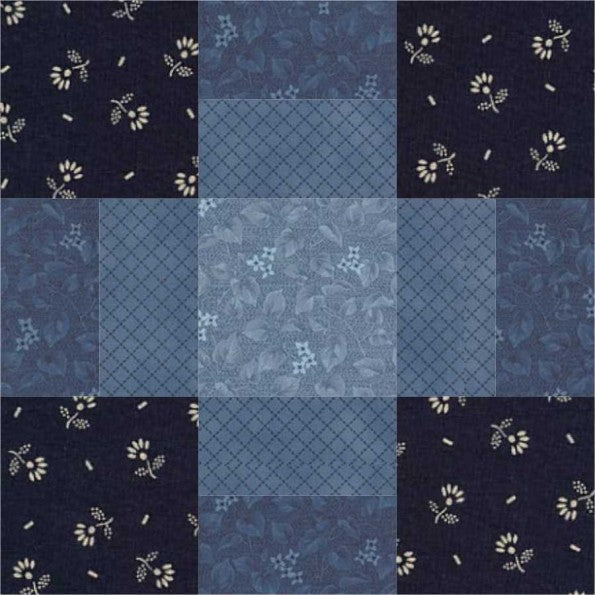
Maggie's Mystery Quilt Block Pattern

To keep these classes free please leave a donation for the teacher here. https://customclothingboutique.com/products/donat-to-motley-muse

Click here for a beginner in depth sewing class on all the basics. https://customclothingboutique.com/pages/quilting-knowledge
Maggie's Mystery Quilt Block is a fun and unique block that involves sewing together several different shapes and sizes of fabric to create a beautiful design. Here are the steps to sew a Maggie's Mystery Quilt Block:
-
Gather your materials: You will need a variety of fabrics in different colors and prints, as well as a rotary cutter, cutting mat, ruler, and sewing machine.
-
Cut your fabric: Using your rotary cutter, cutting mat, and ruler, cut out the following pieces of fabric:
- 2 ½” x 2 ½” squares (4)
- 2 ⅞” x 2 ⅞” squares (2)
- 2 ½” x 4 ½” rectangles (2)
- 2 ½” x 6 ½” rectangles (2)
- 4 ½” x 6 ½” rectangles (1)
-
Assemble the block: Begin by sewing the 2 ⅞” x 2 ⅞” squares diagonally in half, creating two triangles from each square. Then, sew these triangles onto opposite corners of two of the 2 ½” x 4 ½” rectangles, creating two triangle units. Next, sew the remaining two 2 ½” x 4 ½” rectangles to opposite sides of the 2 ½” x 6 ½” rectangles. Then, sew the two triangle units to the top and bottom of the 4 ½” x 6 ½” rectangle, and finally, sew the 2 ½” x 6 ½” rectangles to the sides.
-
Finish the block: Once all of the pieces are sewn together, press the seams open and trim any excess threads or fabric. Your Maggie's Mystery Quilt Block is now complete!
Repeat these steps to create as many blocks as you need for your quilt, and have fun experimenting with different fabrics and color combinations to create a truly unique quilt.
The secret to the nine patch is all about ironing seams so that they butt when they are joined.
Cut 5 A squares and 4 B squares in the required size.
Chain piecing, join a B square to only 3 of the A squares, right sides together, with a 1/4 inch seam allowance. No need to press just yet.
The result will be:

Next, take the remaining A and B squares and, chain piecing, join them to these units, right sides together, with a one 1/4 inch seam allowance:

Your result will be:

To make this faster you can cut strips.
Cut A and B strips for the appropriate width, and join them into A/B/A and B/A/B units. Note you will need twice the length of B/A/B strips, as there are two of these units. Once your strips are joined, right sides together, with a 1/4 inch seam allowance. Press every seam towards the dark fabric.
Cut across your pre-joined strips to create the units needed for the nine patch:

You will achieve the same result as above, but this method is faster.

To make a standard 9 patch, the width of the unit cut from pre-joined strips is the same as the width of the original strips.
Press all the seams to the dark fabric so that all the seems butt up.
Join the B/A/B units to your A/B/A units with butted seams, right sides together, with a 1/4 inch seam allowance.
The direction of the final, central seam is optional. But guided by the placement of the block in the larger scheme, and wherever possible, iron to facilitate budding the seam joints.
Wider Application:
Just as the 4 patch, you can apply this methodology to all kinds of 9 patch blocks. As long as the patch has an underlying 3x3 grid, no matter how many pieces, the basic principle applies. It is repeated over and over, each 9 patch laying adjacent to the next 9 patch. As long as you keep pressing seams in pairs of opposite directions, piecing will be smooth sailing.
Try these out. Each block has an underlying 3x3 grid, and can be pieaced as a 9 patch.

Sometimes it is not obvious which direction is the dark with complicated blocks like those above. Just remember the basic ironing plan is:

How to Resize Quilt Blocks:
The first step in modifying any quilt block is to decide on the size of your finished quilt block. You can come to a decision based on a number of factors: doubling a pattern, cutting your pattern in half, or choosing the size based on your available fabric.
NOTE: When working from a pattern’s cutting instructions, make sure you remove the seam allowance before doubling or tripling the size. For instance, if your pattern calls for 3-1/2″ squares, first you’ll subtract the sum of the seam allowances (1/2″), double the finished block size (from 3″ to 6″), and add the seam allowance back in (1/2″). So, when all is said and done, you will cut a 6-1/2″ piece of fabric.
Resizing Square Blocks:
Square blocks are the easiest to resize. Simply add to your finished block measurement. For example, if you’d like your finished block to be a 4″ square, you’ll need to cut a 4-1/2″ square of fabric.
Resizing Rectangular Blocks:
Similarly to the square, for rectangle blocks, you’ll add to the length and width measurements of your finished block. If you’re doubling block that measures 3″ x 4″ in your quilt, you’ll cut a 6-1/2″ x 8-1/2″ rectangle of fabric.
Resizing Half-Square Triangle Blocks:
When you want to change the size of a Half-Square Triangle block, add 7/8″ to the desired finished block size. To make a 4″ finished block, you’d cut 4-7/8″ squares.
Resizing Quarter Square Triangle:
Since there are two cut lines and two seam lines in a Quarter-Square Triangle block you’ll need to add 1-1/4″ to the desired finished block size. For a finished block that’s 4″, you’d cut your squares 5-1/4″.
